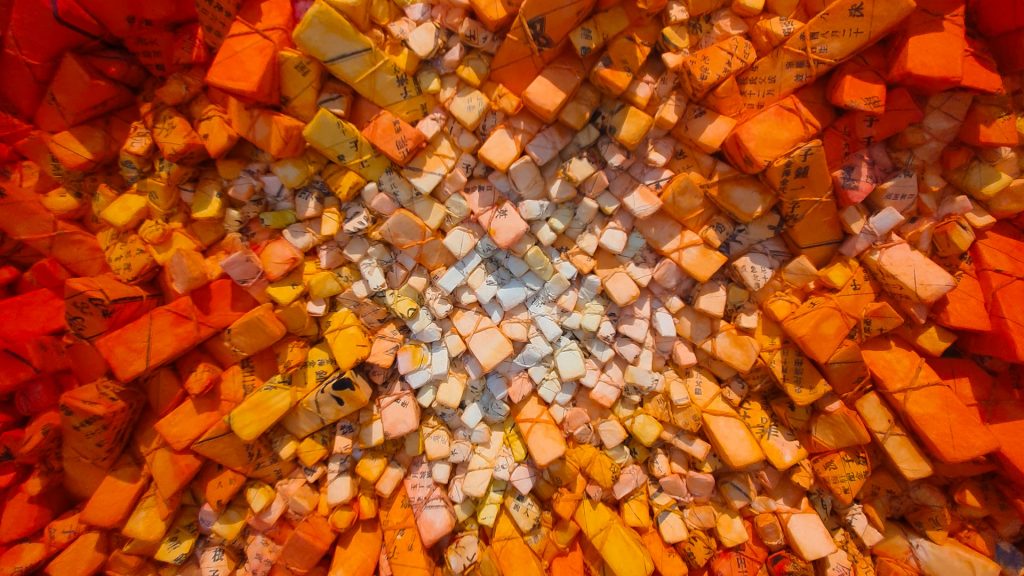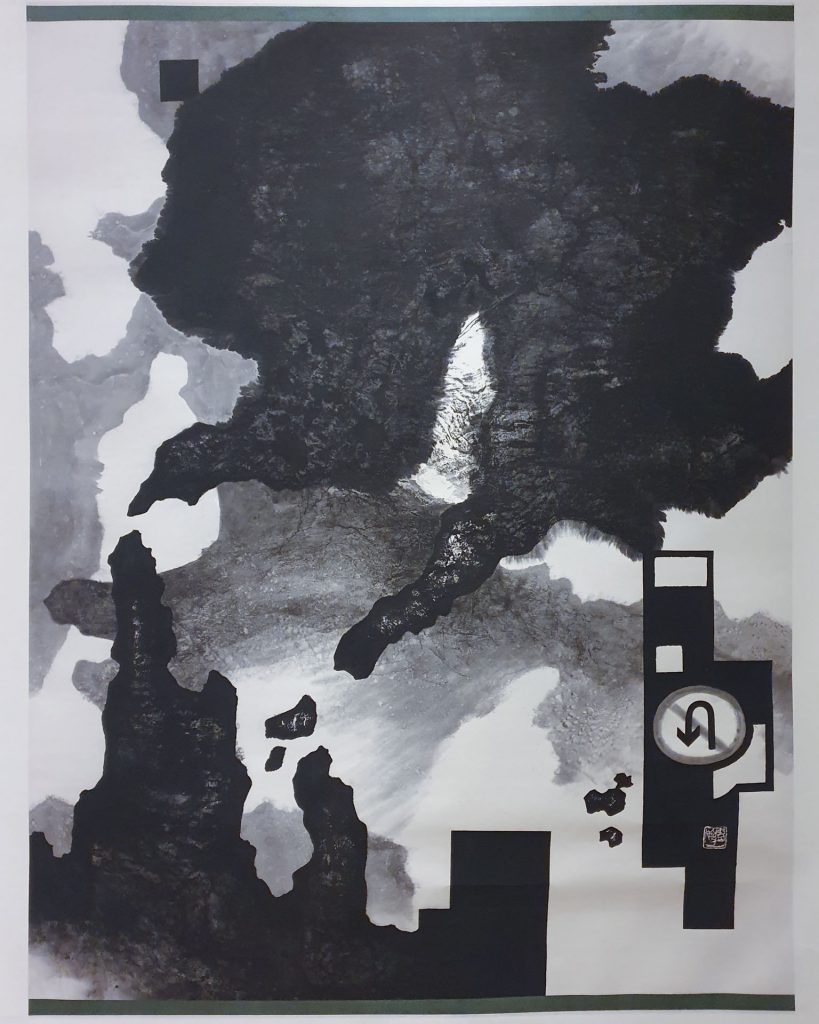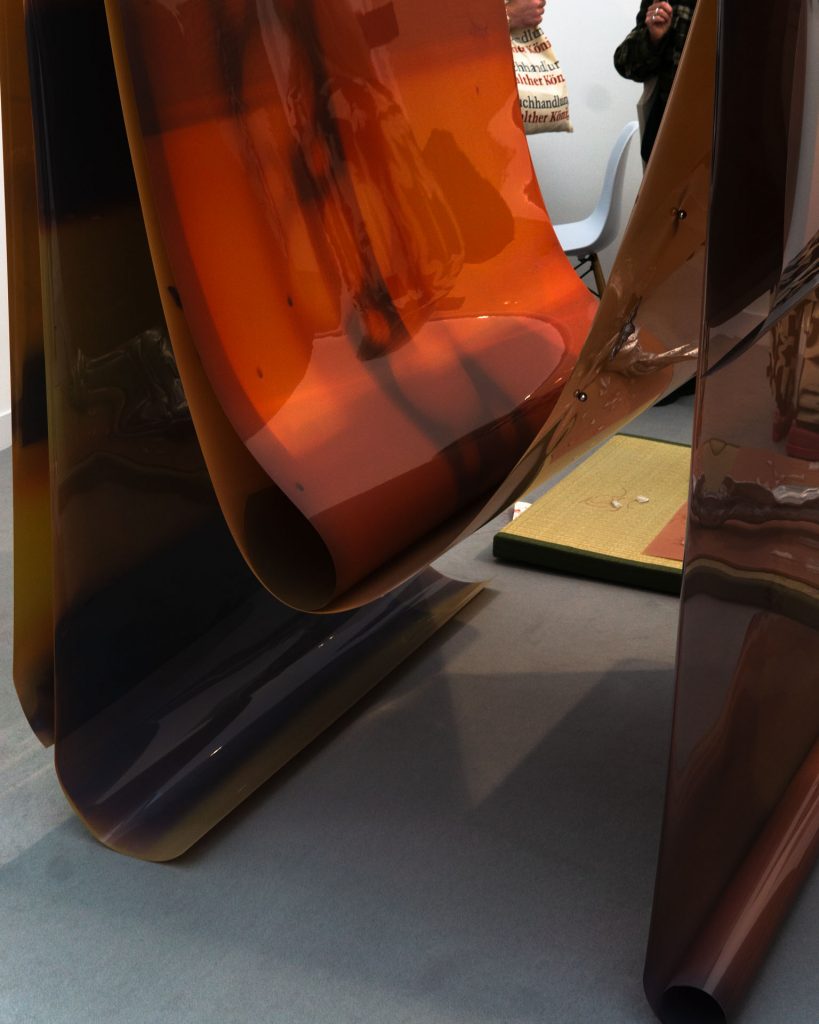This year, I was selected for a Travel Bursary from the Contemporary Art Society, allowing me to head down to London with them to explore Frieze, and to attend a panel discussion with Valeria Napoleone.
Alongside this I also saw 2 other exhibitions whilst in London; Chun Kwang Young’s Inherent Memory, and Strange Wonders: Jizi and pioneers of contemporary ink from China.
Chun Kwang Young : Inherent Memory
Tristan Hoare Gallery
I had previously seen some of Chun Kwang Young’s work at the 2021 Venice Biennale – the intricacy of the small triangular forms wrapped in antique mulberry paper, tinted with various teas or pigments; it is a feast for the eyes. The volume of jagged forms, contrasted with each shadow and reflection of light from a multitude of different angles encapsulates the viewer to pause and get lost in each of the works.

Chun’s signature technique is reminiscent of childhood memories, medical herbs wrapped in Mulberry paper and hung from the ceilings of the local doctor’s office. This link to his Korean heritage and merging these techniques into his art is astounding. Chun takes countless Korean books and wraps the pages around polystyrene shapes, giving each one its own individuality. Although not able to read Korean, I find the writing upon each shape inspiring, as it further emphasizes the nature of our species – history being lost to time, and yet reused or rebirthed into new and exciting ventures. Chun’s work will always be a treat to witness firsthand.
Strange Wonders: Jizi and pioneers of contemporary ink from China
Brunei Gallery
After this I then went to the Brunei Gallery at the SOAS University of London, where the Strange Wonders: Jizi and pioneers of contemporary ink from China was on display. This exhibition was intriguing, for the way it was hung and put together, but also the content. Large ink works on rice paper clad the walls throughout the lower level of the Brunei Gallery, a mix of celestial and the everyday amalgamated into various pieces; pockets of space and entrances to other worlds.

Otherworldly forms, statues emerging from the dark, planets and celestial bodies above mountains, stone paths atop geometrical obelisks, stamped writing freefalling in nothingness, and road signs reiterating that there are no U-turns allowed here.
Jizi’s work is born from experience, and his research into Buddhist and Daoist classics. At first glance the works seem chaotic, nonsensical, and yet when looking closer the works feel at peace – floating through an ethereal plane of existence. Everything fits together, flowing into each other, and overall just provides a real sense of calm. No U-turns, once you have seen this work, it will stay with you in a way.
“The rules say ‘use form to draw spirit’, but I in fact ‘use spirit to draw form’.”

FRIEZE LONDON

Paula from CAS gave the group a tour of select stalls within Frieze. Starting with a solo presentation of Lotus L. Kang’s work from Franz Kaka. This interested me in a few ways; colour, form, content, and process. The colours were evocative, a very specific orange-brown found in photographical development processes stands out from the white cube environment as large sheets of film tower above you. Franz Kaka has stated that these film sheets are continually-sensitive leading me to believe that they are similar to some of Lizzie King’s work, whereby I mean they are continually being exposed to light and are slowly continuing to develop chemically. The vague shapes of the rafters and scaffolding holding the Frieze tent above is evident on a few of these sheets, now exposed as a warm thermal glow. As someone who is used to working with 35, 120, and 127 mm film rolls, the work being presented leads me to be taken-aback from the sheer scale of the material used.
We next viewed the Dust that never settles (2024) by Nour Jaouda, which is one of 2 works that CAS has acquired by women artists through the CAS Collections Fund for The Hepworth Wakefield.
This work is based in fabric dye and pigment on canvas, and is another piece that I couldn’t help but become lost in the details of. This large-scale textile stands at the threshold of painting and sculpture, Jaouda’s work is inspired by her immediate surroundings; these being cosmopolitan cities, and prayer mats that are seen in Egypt. Vibrant blues and ochre yellows, the work is a delight to look at, and could easily be interpreted in many ways by different viewers. For me it was almost as if natural forms and plants were emerging from manmade panels, the brightest of the blues and yellows breaking through the segmented subdued colours.


Sonic Gym – Milky Coiffured Cosmic Compression (2019), by Haegue Yang. A sculptural work that wasn’t meant to be still – the work was spun for us, the individual bells used in its construction rang, and the plastic twine splayed outwards from the inertia. This work is part of a series of Sonic Sculptures that started in 2013, many of which also use bells, as these have been a staple element that many cultures adopt; from tribal societies to the modern era, this adding a layer of mythic and ritualistic memory to Yang’s work. Unique visual patterns and sounds are experiences after a state of silence and immobility; something I wish to see again in a quieter environment to fully appreciate its intricacies.
Valeria Napoleone xx Contemporary Art Society
CAS then took us to Valeria Napoleone’s residence/ gallery – the walls of this London Terrace were filled with artwork by various female artists over the years; as Napoleone has been collecting work since the 1990s, there is no lack of it. Ranging from paintings to sculpture, small and large, it was a collection to behold.

The following talk between the CAS members and Napoleone was interesting to me as it was an in-depth introduction to select works that VN xx CAS has acquired since its founding in 2016, and then gone onto be presented in various CAS affiliated Museums such as: Leeds Art Gallery, Norwich Castle Museum & Art Gallery, Manchester Art Gallery, Royal Pavilion & Museums Trust, The Hunterian, Bristol Museum & Art Gallery, York Art Gallery, and the Scottish National Gallery of Modern Art.
I was intrigued by the 1973 film Antepartum by Mary Kelly – a film acquired for Brighton & Hove Museums through VN xx CAS. Kelly’s work is renowned for introducing feminist concerns into the male dominated space. This film being part of a series of works that focus on the experience of pregnancy and motherhood. Black and white close-up shots, the film portrays a pregnant stomach at full term; the film showing the subtle rising and falling of the abdomen as breath is drawn and then exhaled. Part of the reason for my intrigue is that of physicality and the material that is used to capture this work – analogue film (converted to DVD for digital conservation). The look and feel of film is one that captures natural environments and life so well compared to the digital medium of today (in my opinion); it has a unique quality that captures the soft details and subtle movements to great effect.
The kindness of Napoleone, everyone at the Contemporary Art Society, and the other organisational representatives knew no bounds. Even a full month later I am still digesting the amazing work I saw, and cannot thank the Contemporary Art Society enough for this opportunity.
Also a quick shout out to Kate from Tate, Megan from North Yorkshire Council, and Kirsty from Dundee as we spent most of the day discussing art and our different roles respectively.
